Michelangelo's Moses and his little finger
Have you ever wondered the connection between biology, art, Michelangelo's Moses, passion, frustration, and the edge of madness. Read this article. find that connection and more.
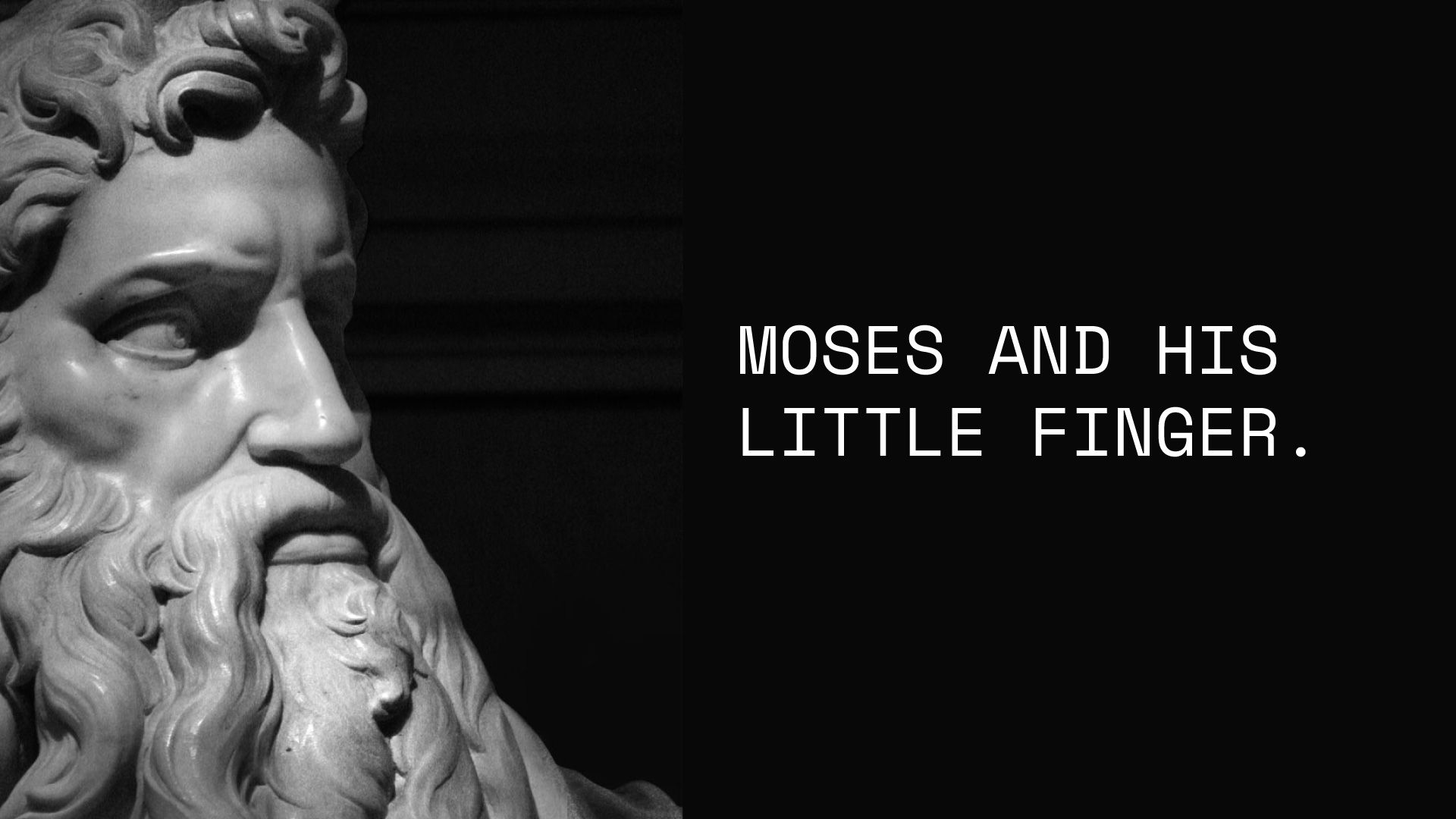
In this little article, I will walk you through the connection between biology, art, the artist's mind (Michelangelo), passion, frustration, and the edge of madness. Not in any particular order.
As someone who works in technology day in day out, it helps to know different disciplines. It will help us become more rounded in consulting. If not anything, it will at least make an interesting coffee conversation, I promise.
Michelangelo (born in the year 1475) is known for his works like Pietà (1498-99), David (1501-04), Madonna and Child (1501-04), Sistine Chapel (1508-12), Moses (1513-15) and so on. I stopped at Moses because it is the object of my interest for this article. Sure, his other works like David and Sistine Chapel's ceiling are more famous than others. However, if you wear the right lens and look closely, every single piece of Michelangelo's work is a work of wonder and marvel. Let me demonstrate a glimpse of what I mean.
Take a look at Moses a bit closely. Check the below image 1 and zoom through the details of the sculpture. Michelangelo, the master artsman that he is has filled this sculpture with as much drama and potential energy as possible. Zoom in a bit more till you see the definition and details of the sculpture and you'll notice what I mean — Look at the way his left foot is pushed a little back as if he is about to rise from that throne. Look at the way he is holding his slipping robe with his left hand above the right knee to expose it to help him rise up without hindrance. Look at the way his right shoulder is slightly tilted in the opposite direction to his left foot movement to build that energy. Look at all the tension built up in those clearly defined muscles.
The more you look closely the more you can hear the subliminal poetry asserting itself on you. It'll become less about the sculpture and more about the invisible beauty monster, born in the depths of your cerebellum, and medulla oblongata, while you look at that art and get drawn to it. It cannot stop talking to you, connecting dots and weaving words and you cannot stop listening. It takes you through a ride through the depths of the art ocean in front of you. It does that with utmost aplomb and while dancing with confidence adding a little jiggle in it. I can go on and on about his face and gaze towards his left and other details but, you get my point about the drama, the energy flow and the way it makes you feel. Agnes Martin gets it, she says:
"Art is the concrete representation of our most subtle feelings."
While you are noticing all that, you also have to keep in mind that this sculpture was chiseled on a marble stone painstakingly picked to work on around the time when Columbus arrived in America and accidentally discovered it. Yes, it was from a time when the world didn't know a whole continent existed.
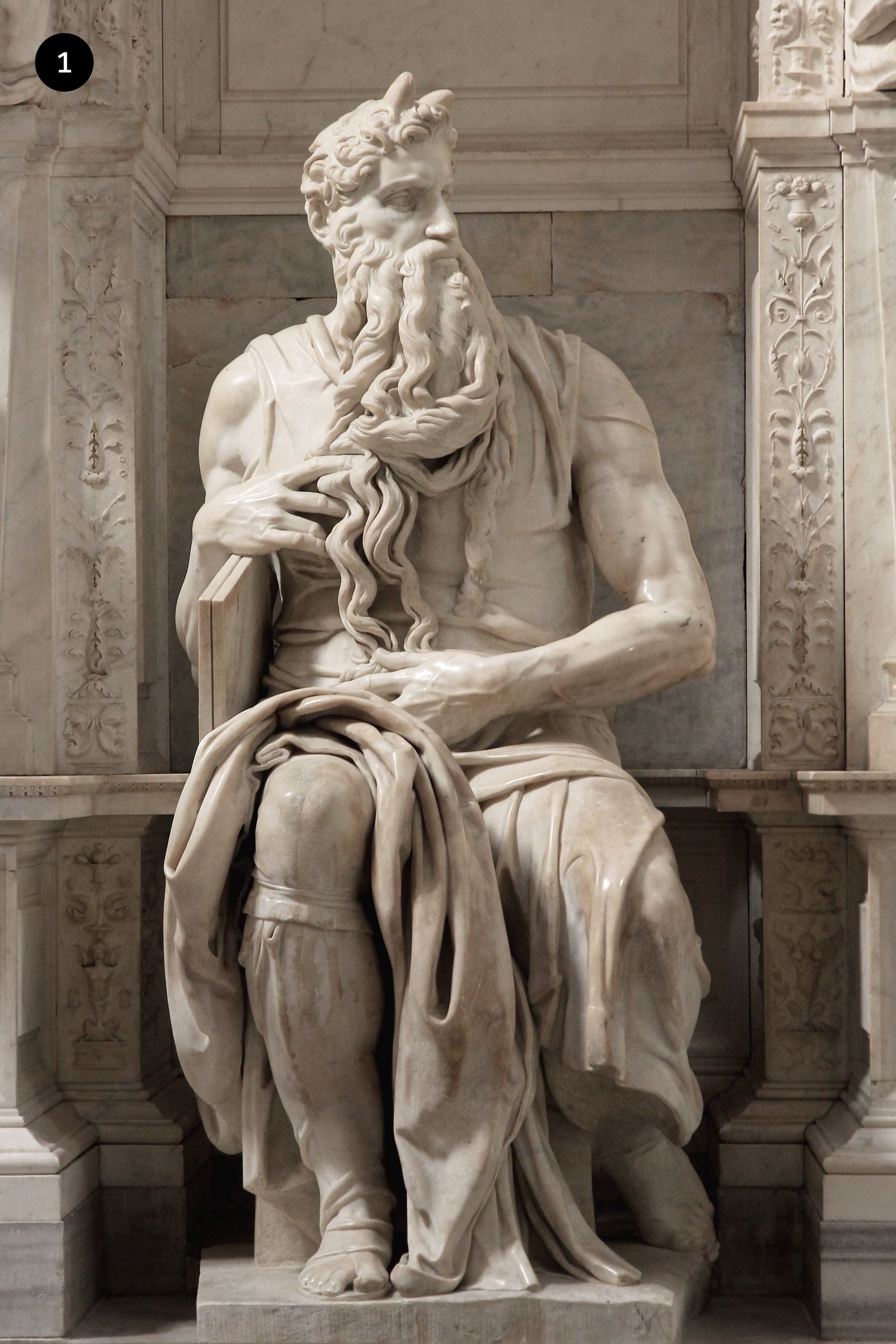
Now to go a bit deeper into those details we need biology 101 here. Don't be scared, it's just the forearm biology. Check the below image set 2 which shows various groups of muscles in our forearm. 20 muscle groups to be precise, divided into posterior and anterior compartments. Whether you want to simply move a single finger or want to hold your coffee cup or want to grip a 24 lb dumbbell in your fist, you either require all or some of these groups to enable you. For our discussion let's just focus on a particular muscle group called extensor digiti minimi which are a part of the posterior compartment. Follow the purple group of muscle tissue in the below image. Extensor digiti minimi is an accessory extension to support the little finger's movement — that's all we need to know for now.

Now back to Moses. Check the below image 3 and follow the blue circle. It points to extensor digiti minimi muscle tissue carved on the marble. See how that group is a bit pronounced and clearly defined and polished on the sculpture? Now see the little finger of the right hand. Two red arrows, one pointing to the slightly elevated part of the finger and the other to the ripple at the root of the little finger. The thing about extensor digiti minimi is that it only becomes visible and pronounced when the little finger is lifted or moved a bit. Otherwise, it is mostly invisible.
All this is to describe one little muscle on the forearm of that sculpture. Now, imagine the details and biology behind all the other muscles put together. To me, capturing such intricate details on this sculpture some 500 years ago is utterly insane. To me, this makes the art timeless. This gives the art its true beauty. This is the reason why Michelangelo is considered one of the greatest artists ever to have walked this planet — The master.
No muscle on this sculpture is out of its place or isn't in sync with the drama that's being portrayed by the master. Everything is precisely calculated and carved in stone to perfection. The amount of knowledge Michelangelo possessed on human anatomy can only be compared and paralleled with Leonardo da Vinci. They say, the devil is in details but, all I see is God in these tiny hidden details, waiting to be rediscovered by bringing art, science, and engineering disciplines together. It's not done yet. There's more to this story.
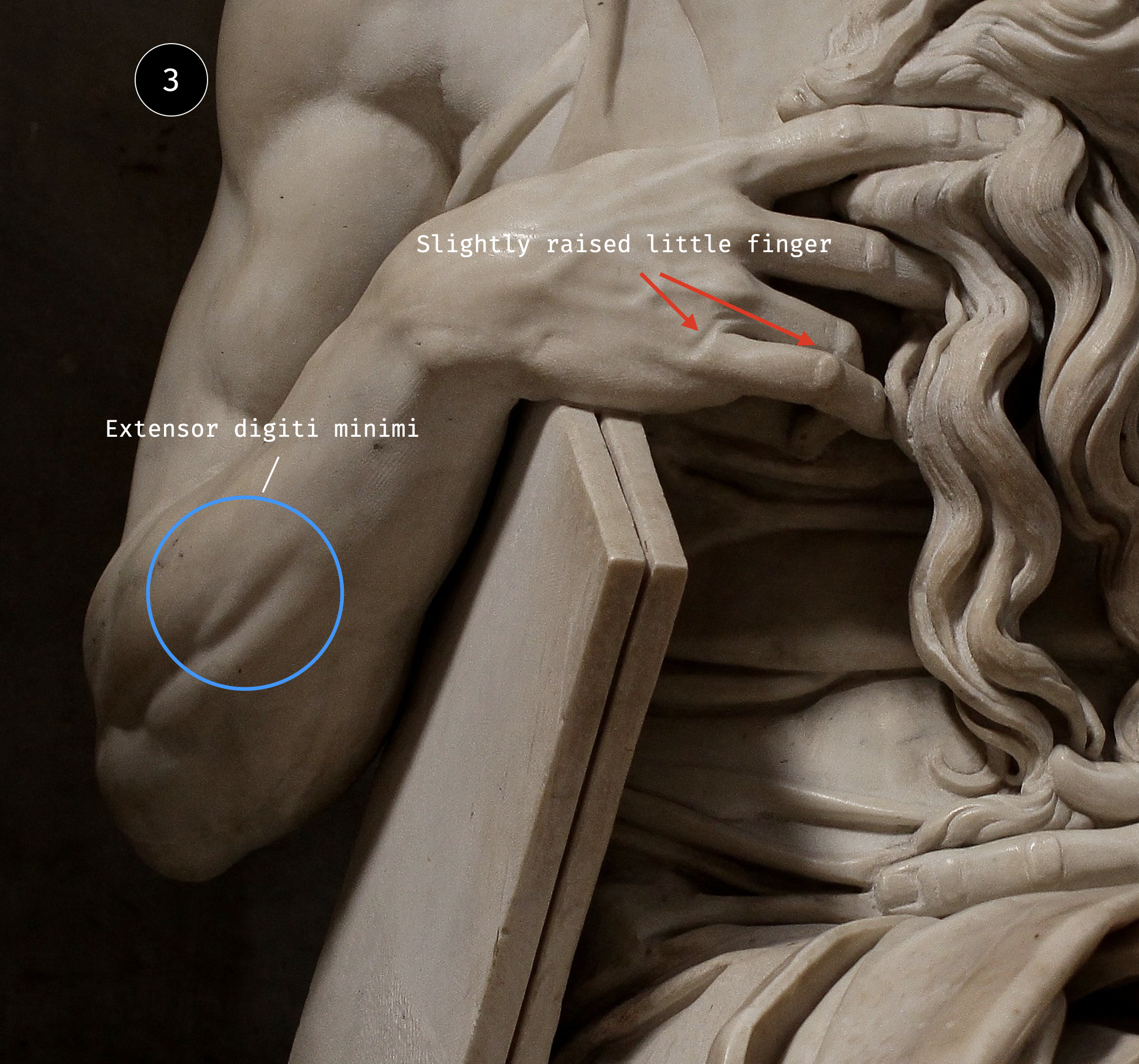
Although Michelangelo was so passionate about his work, as an individual he was considered a bit hot-tempered, a bit brooding, and a bit difficult to work with. To simply put, he was a complex man who just loved his work. Of all his works, I picked Moses because something interesting happened with this sculpture. There are some accounts and speculations that cannot easily be separated from facts or fiction but, they say — Towards the end stages of finishing Moses, Michelangelo was so involved with it, he started speaking to the statue while working on it. Personifying and treating it like a real human. When the statue didn't respond or speak back to Michelangelo, he got so furious and frustrated that he slammed down his hammer on the right knee of the statue in a fit of rage and anger. They say you can see the damage caused by his hammer blow on the right exposed knee of the statue and possibly the toe as well. I tried to depict the possible hammer blow path in the below image 4.
Unknowingly, the master got so emotionally involved with his subject, Moses. To his mind, the statue seemed real and alive. In reality, it was just a statue. There was no life in it. There never was. The emotional attachment made it all real for Michelangelo. He gave his everything to do complete justice to his work and the work in return looked more and more real to make the artist lose his grip reality more. It's like an unstoppable force meeting an immovable object. Yin-yang of order and chaos lurking within each other, waiting for the perfect moment to strike and change the outcome of our reality.
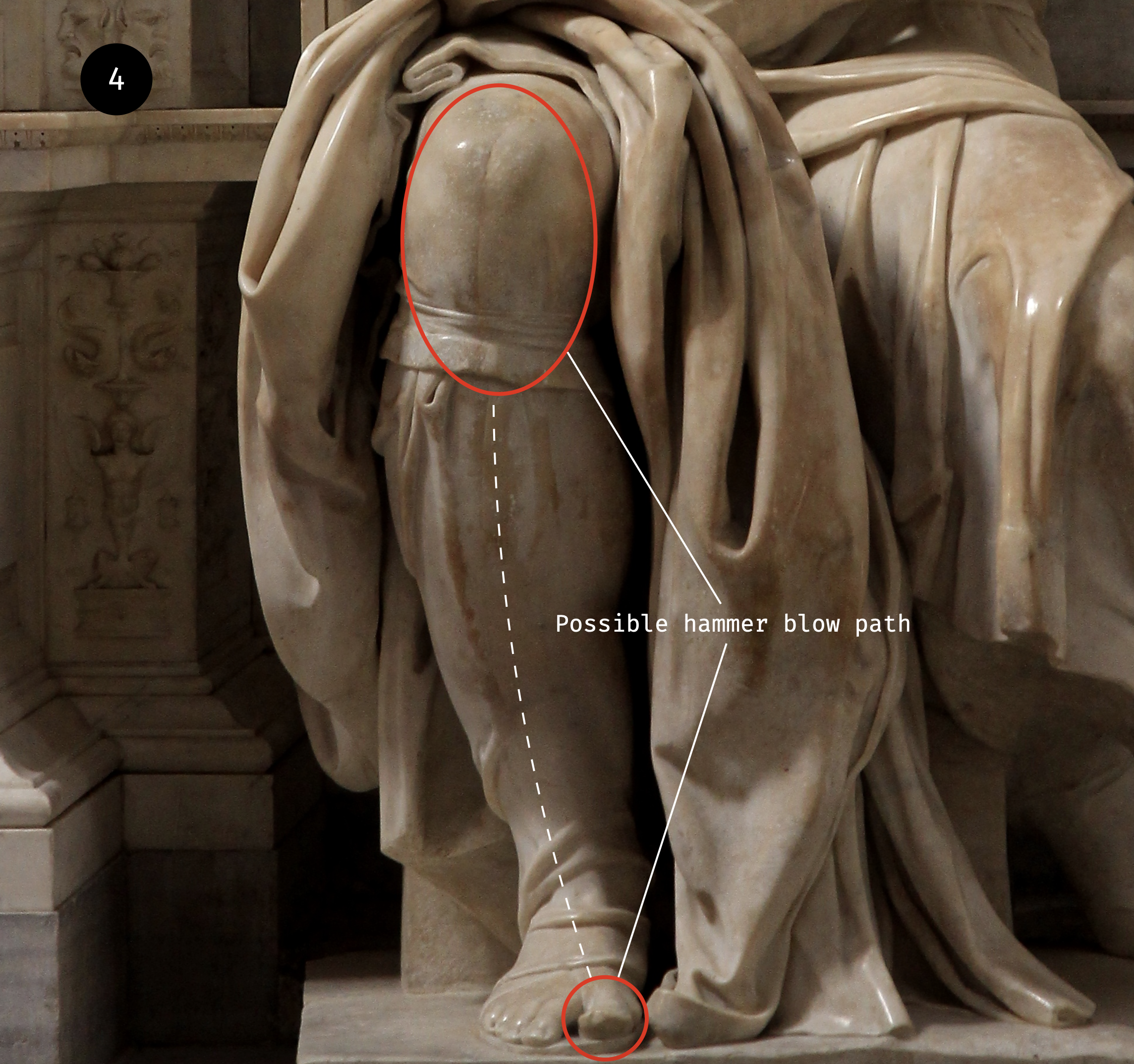
Passion and frustration are like two sides of the same coin. The thing that we grow fond of and become passionate about is the one that possesses the power to frustrate and damage us the most. Sometimes to the edge of madness and insanity if we are not aware of the works of our mind.
There are two things that one needs to be aware of in a situation like this — One, on chasing perfection in an eternally imperfect world. We have to be aware that perfection cannot be achieved ever. That which we think is imperfect is perfect in its own sense. We need to clear our mind to see it. Two, those who love hard also have the propensity to hate hard. They go all in. But then, if you cannot go all the way in then have you even lived? What's the point of life if you cannot follow what truly matters and what truly makes you happy? Why do we end up restricting ourselves? Where do these restrictions come from? The key to true freedom of self is to understand the nature of these proverbial restrictions our mind constructs based on our past experiences. The biggest restriction is our mind itself. Then the greatest freedom there is, is to be free from our own mind.
Coming back to Michelangelo, it didn't quite stop there. For the master, the physical beauty of his work got lost in the labyrinths of his chaotic mind in the years that followed. You can see how much his work slipped in his — The Duomo Pietà (the deposition). Check image 5 and the first thing you might notice is the irregularities and disproportionate limbs on the sculpture. No drama, no potential energy in the sculpture. The imperfections are so troubling that you cannot compare this work with any of his earlier works. See image 5 below and the highlighted red circles to check these imperfections.
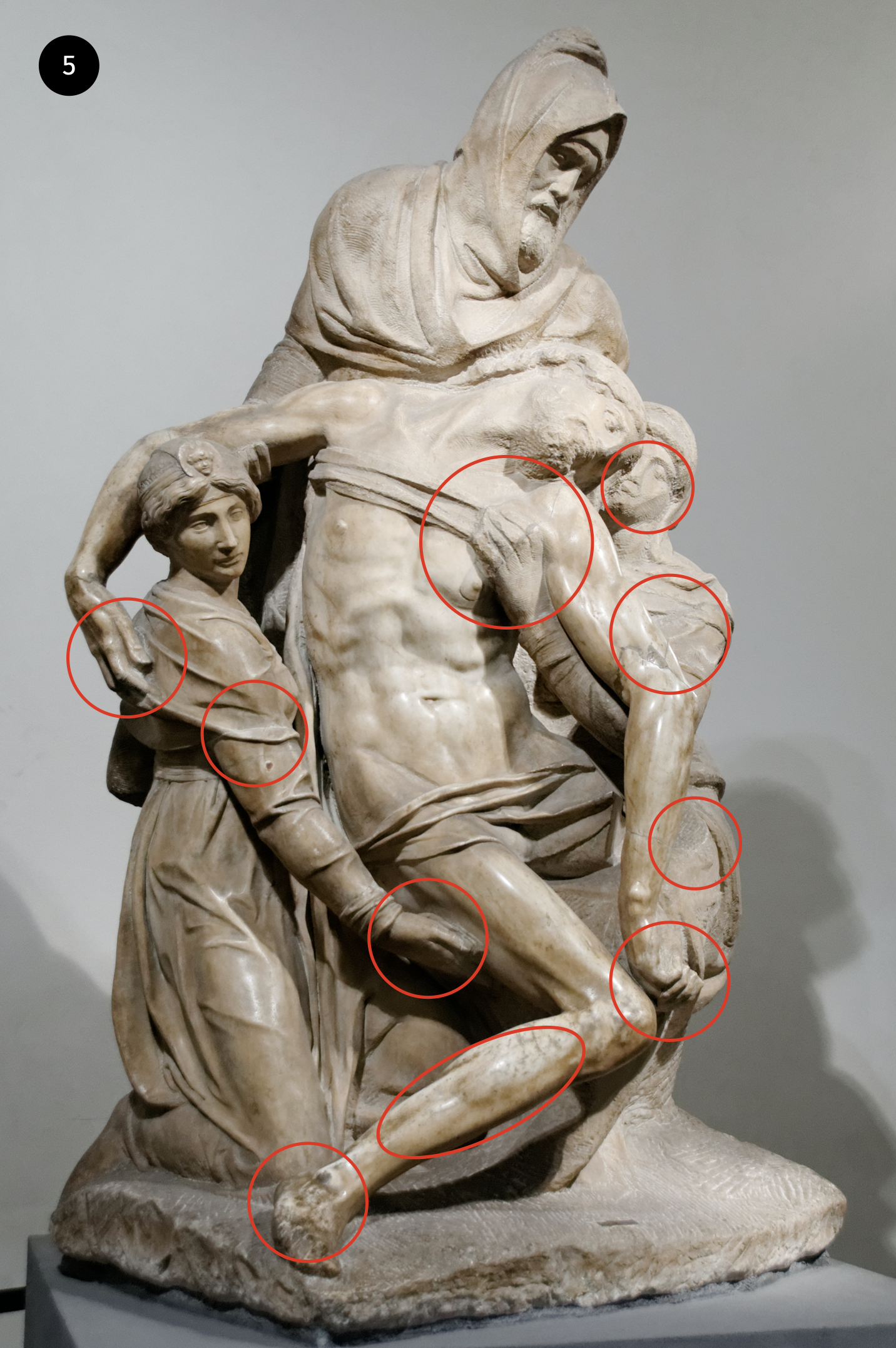
After nearing the completion, Michelangelo smashed the statue with his hammer, he struck it hard everywhere possible. Leaving us no clues to find the parts that might have troubled him. To me, this is not a true tragedy. The true tragedy came much after. In the form of covering and fixing the damage done by the master. In the form of another sculptor, the second sculptor, Tiberio Calcagni. He was given the job to fix and restore the piece. Every act of fixing the original piece, chiseling the edges, and polishing the surface erased the original vision, the delicate touches and the evidence of madness left by the long-gone master. This to me is the real tragedy.
